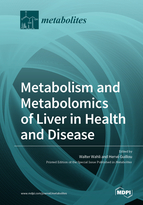Metabolism and Metabolomics of Liver in Health and Disease
A special issue of Metabolites (ISSN 2218-1989). This special issue belongs to the section "Lipid Metabolism".
Deadline for manuscript submissions: closed (30 April 2020) | Viewed by 76532
Special Issue Editors
2. Center for Integrative Genomics, University of Lausanne, CH-1015 Lausanne, Switzerland
Interests: nuclear receptor superfamily; gene regulation and gene expression profiling; metabolic regulations; development; skin and wound healing; cancer; liver physiology; non-alcoholic fatty liver disease (NAFLD) and non-alcoholic steatohepatitis (NASH); adipose tissue; muscle and exercise; gut; microbiota; inter-organ cross-talk; nutrition; nutrigenetics and nutrigenomics
Special Issues, Collections and Topics in MDPI journals
Interests: metabolism; lipidomic; nuclear receptor superfamily; gene regulation and gene expression profiling; metabolic regulations; liver physiology; non-alcoholic fatty liver disease (NAFLD) and non-alcoholic steatohepatitis (NASH); microbiota; inter-organ cross-talk; toxicology; nutrition; endocrinology; nutrigenetics and nutrigenomics
Special Issue Information
Dear Colleagues,
In this Issue, we will explore the use of targeted and untargeted metabolome analysis to investigate liver function in health (physiology) and diseases such as viral hepatitis, alcoholic liver disease (ADL), non-alcoholic fatty liver diseases (NAFLD), drug-induced liver injury (DILI), and autoimmune liver diseases.
Our aim is to underscore, through research and review articles, the broad prospects of systems biology and metabolomics for a better understanding of liver function in basic research and possible clinical applications of drug discovery, toxicology, and biomarker identification.
Prof. Dr. Walter Wahli
Dr. Hervé Guillou
Guest Editors
Manuscript Submission Information
Manuscripts should be submitted online at www.mdpi.com by registering and logging in to this website. Once you are registered, click here to go to the submission form. Manuscripts can be submitted until the deadline. All submissions that pass pre-check are peer-reviewed. Accepted papers will be published continuously in the journal (as soon as accepted) and will be listed together on the special issue website. Research articles, review articles as well as short communications are invited. For planned papers, a title and short abstract (about 100 words) can be sent to the Editorial Office for announcement on this website.
Submitted manuscripts should not have been published previously, nor be under consideration for publication elsewhere (except conference proceedings papers). All manuscripts are thoroughly refereed through a single-blind peer-review process. A guide for authors and other relevant information for submission of manuscripts is available on the Instructions for Authors page. Metabolites is an international peer-reviewed open access monthly journal published by MDPI.
Please visit the Instructions for Authors page before submitting a manuscript. The Article Processing Charge (APC) for publication in this open access journal is 2700 CHF (Swiss Francs). Submitted papers should be well formatted and use good English. Authors may use MDPI's English editing service prior to publication or during author revisions.
Keywords
- Liver functions
- Fatty liver
- Liver diseases
- Molecular mechanisms and biomarkers








